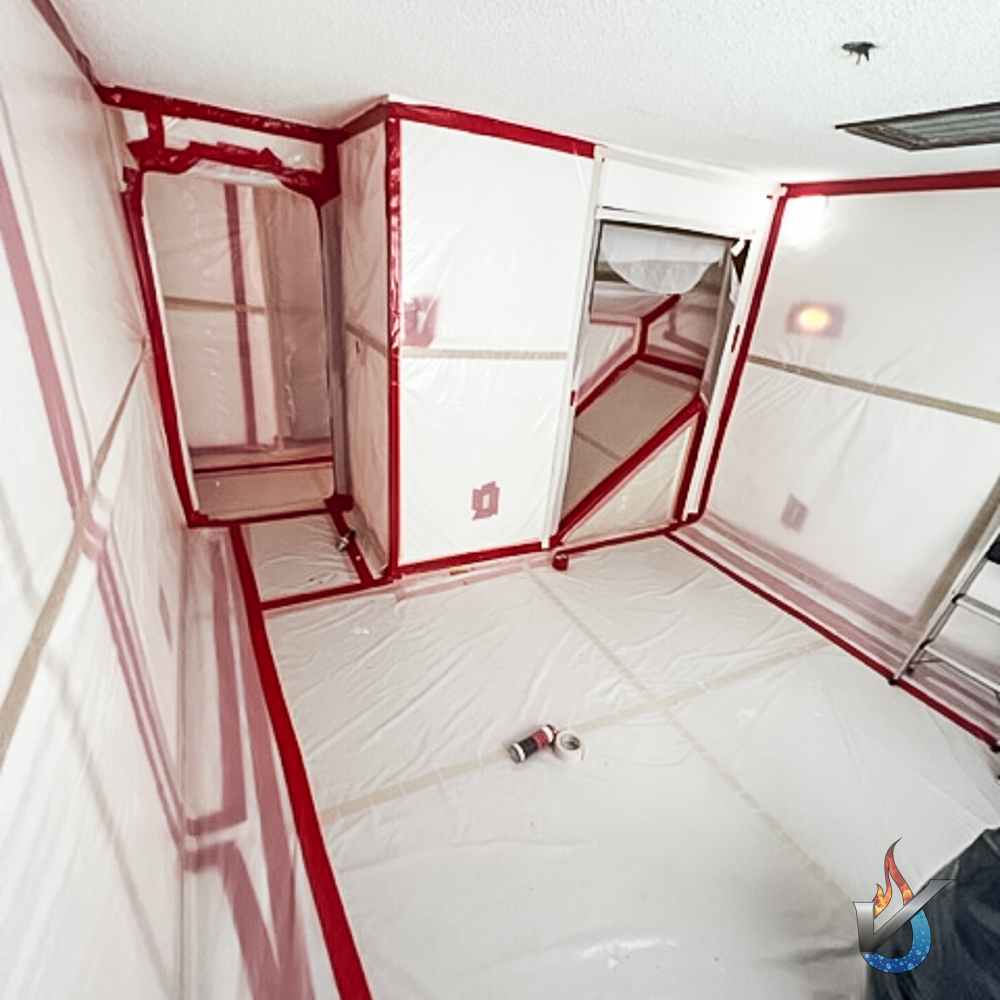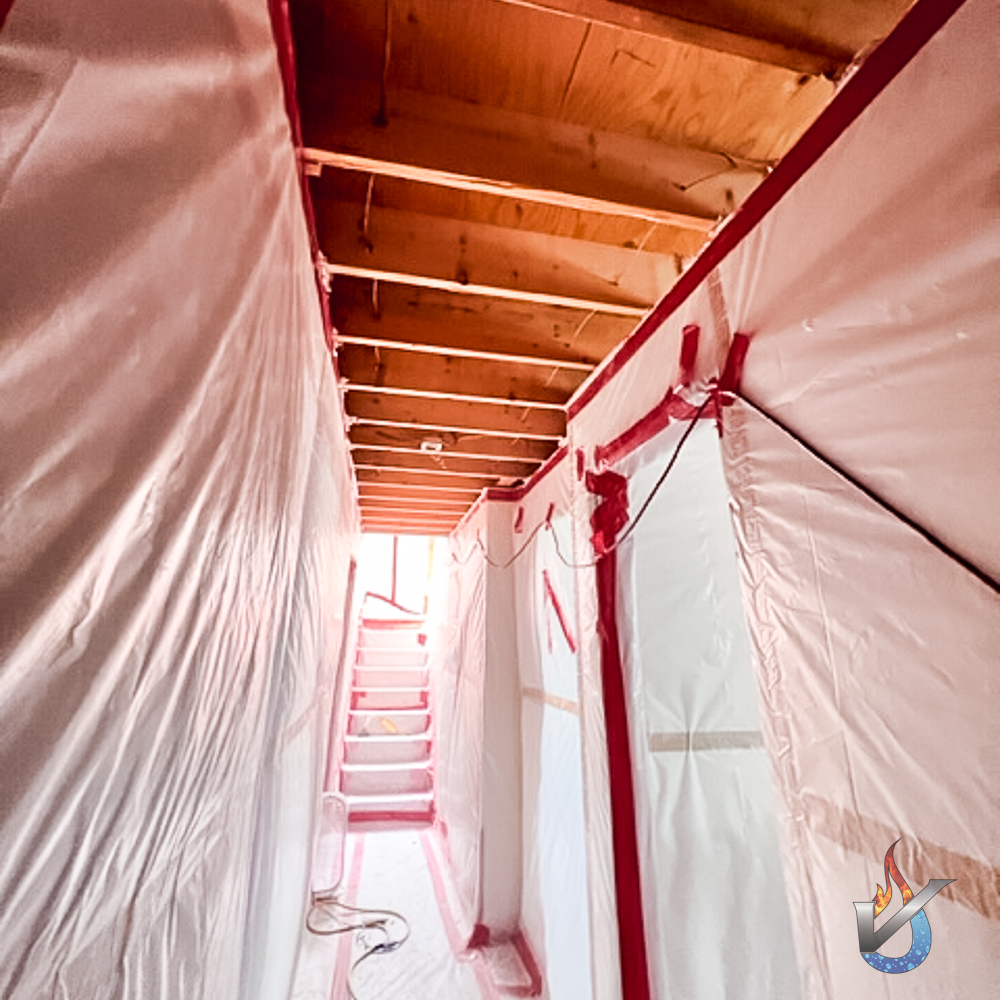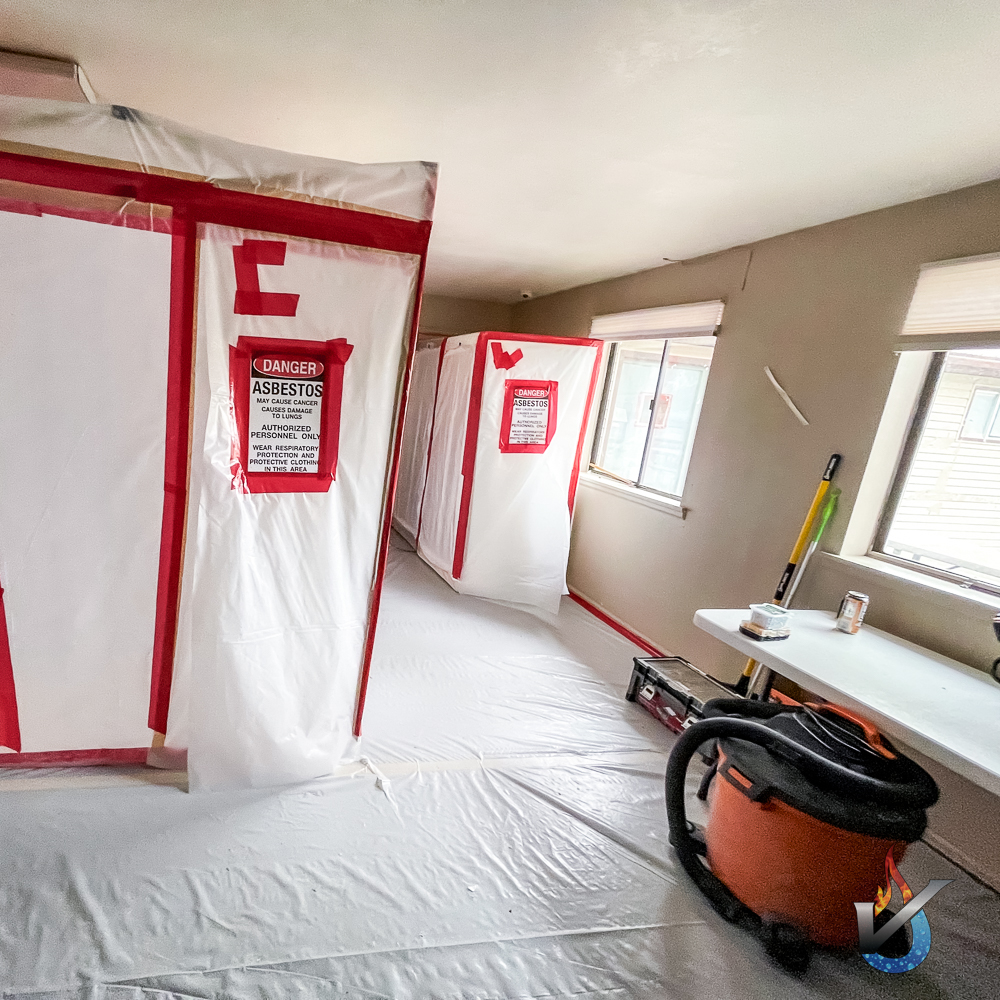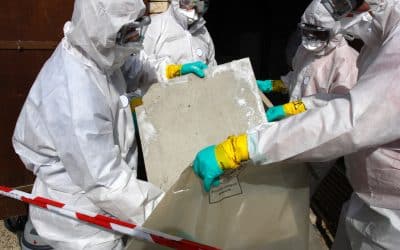Asbestos Abatement & Cleanup
We have helped over 100 homes and business owners overcome these issues and safely removed asbestos from walls, floors, and ceilings. If you live in our Western Colorado service area and are concerned about Asbestos, call us today!
Need to Test or Abate Asbestos?
Asbestos is Dangerous
Asbestos is a naturally occurring mineral fiber found in rocks and soil worldwide. It has been used since ancient times as an insulator, fire retardant, and heat-resistant material. Asbestos was once commonly used in building materials such as roofing shingles, floor tiles, ceiling tiles, insulation, and pipe linings. However, because of concerns about possible health, its use was banned in Canada in 1976. Nowadays, most countries have followed Canada’s lead and banned its use in construction materials.
Many older homes were using asbestos for thermal insulation. When asbestos is disturbed, it releases fibers that enter the lung system and can cause lung cancer.
The main types of asbestos include chrysotile (white), amosite (brown), crocidolite (blue), and tremolite (green). Exposure to these substances may cause lung cancer, mesothelioma, asbestosis, laryngeal cancer, and other diseases.
The International Agency for Research on Cancer (IARC) classifies asbestos as a Group 1 carcinogen. In addition, IARC states that “there is sufficient evidence in humans for the carcinogenicity of all forms of asbestos.”
The U.S. Environmental Protection Agency (EPA) estimates that more than 100 million tons of asbestos were mined worldwide between 1900 and 1980. The EPA says that approximately 1,000 people die annually due to asbestos exposure.
Contact your doctor immediately if you suspect you may have been exposed to asbestos. Your doctor will perform tests to determine whether you have been exposed to asbestos. These tests include chest X-rays, blood tests, and pulmonary function tests (PFT). A PFT measures the air that flows into and out of your lungs. The results of these tests can indicate whether you have developed an asbestos-related disease.
If you test positive for asbestos exposure, your doctor may recommend further testing to confirm the diagnosis. In addition, they may refer you to a provider specializing in treating people with asbestos-related diseases.
Asbestos problems must be dealt with by professionals with the proper equipment, protective gear, and know-how. We have dealt with asbestos problems throughout the Western Colorado Slope at Valley Restoration and Construction.
Process
How Asbestos Abatement Works
When asbestos becomes friable (is damaged and disintegrates)—as, for instance, during a home renovation or by wear and tear—it releases fibers that can find their way to the lungs. Asbestos exposure can cause lung and other types of cancers and should be abated immediately. The first step is identifying whether your home or office has an asbestos problem. Valley Restoration and Construction will have your site tested. Once we have determined which parts of the buildings contain disintegrating asbestos, we isolate the area and mark it as hazardous. We turn off the HVAC system and seal the air ducts to stop the fibers from further spreading throughout the building.

With protective gear on and respirators, we remove the asbestos containing building materials and replace them with asbestos-free materials. Depending on the specifics and the extent of the problem, we can also encapsulate the asbestos with unique materials that will stop asbestos fibers from dispersing.
Dealing with asbestos often requires a negative air containment, decontamination chamber where we remove our protective gear and waste load-out chamber. We take extra care with the removed asbestos material, which is placed in sealed bags or containers, clearly labeled and properly disposed of at an EPA approved landfill for friable asbestos waste.
When we finish, we vacuum the space with professional vacuums that carry HEPA filters to catch the released fibers and prevent them from circulating. Often, the area must be inspected and cleared by a third-party certified Air Monitoring Specialist. Once the space is cleared your home or office is ready for the rest of the renovation or demolition process.
Whether your project is commercial or residential, any repairs to older structures may involve asbestos-containing material (ACM). The State of Colorado has a mandated protocol that must be followed before any disturbance or removal.
Let Valley Restoration & Construction Keep You Safe From Asbestos
Valley Restoration & Construction is a certified Colorado State General Abatement Contractor (as required by Regulation 8, Part B) and can help with asbestos abatement, including repair, encapsulation, enclosure, and removal.
If you suspect asbestos exposure in your building, contact Valley Restoration and Construction immediately. You can make your property safe and free of hazardous materials with a simple phone call!
Learn More About Asbestos Abatement & Cleanup
Asbestos Mitigation
The words "asbestos removal" will rightly make most homeowners worry. We have all heard how dangerous asbestos can be, as it can cause cancer and lung disease many years after exposure. Even so, asbestos does not always need to be replaced or sealed. A proper...
How Can I Detect Asbestos in My Home?
How Can I Detect Asbestos in My Home? Asbestos used to be an insulating material until the early 1980s, when it was discovered that asbestos may become friable and release airborne fibers that can be detrimental to a homeowner’s health. Because of those fibers’...
The History of Asbestos
Asbestos is a dangerous material that was used regularly up until the 1970’s. When it forms, it takes the shape of filament-like crystals. Unknown to people of the past, disturbed asbestos causes the filaments to float around in the air. When we breathe asbestos in,...
FAQs
Common Asbestos Questions
What is asbestos?
Asbestos is a group of naturally occurring fibrous minerals that were widely used in various building materials due to their strength, heat resistance, and insulation properties. Common asbestos-containing materials include insulation, roofing, siding, sheet vinyl, floor tiles, surfacing materials (texture and plaster) and popcorn ceilings.
Why is asbestos a concern?
Asbestos is a concern because inhalation of asbestos fibers can cause serious health problems, including lung cancer, mesothelioma, and asbestosis. These risks are associated with long-term exposure to airborne asbestos fibers, which can occur when asbestos-containing materials are damaged or disturbed.
How can I tell if my home contains asbestos?
The only way to confirm the presence of asbestos in your home is to have suspected materials tested by a certified asbestos inspector and laboratory. Visual inspections are insufficient, as asbestos fibers are microscopic and cannot be seen with the naked eye.
Is it safe to remove asbestos on my own?
Removing asbestos on your own is not recommended, as improper handling can release asbestos fibers into the air, increasing the risk of exposure and related health problems. Furthermore, Colorado is one of the few states that regulates asbestos removal in both residential and commercial spaces. Permits are required before abatement can begin, and failure to follow the state’s regulations regarding removal amounts and disposal can result in fines and penalties. Therefore, asbestos abatement should be performed by licensed and trained professionals who follow strict safety guidelines and regulations.
Are there any laws or regulations governing asbestos abatement?
Yes, asbestos abatement is regulated at the federal and state levels in the United States. The Environmental Protection Agency (EPA), the Occupational Safety and Health Administration (OSHA), Department of Transportation (DOT) and state environmental and health agencies have specific guidelines and requirements for handling and disposing of asbestos-containing materials. Hiring a licensed asbestos abatement professional who adheres to these regulations is crucial to ensure a safe and compliant project.
What is asbestos abatement?
Asbestos abatement is safely removing, encapsulating, or repairing asbestos-containing materials to minimize the risk of exposure to airborne asbestos fibers. Abatement methods depend on the asbestos-containing materials’ type, condition, and location.
How much does asbestos abatement cost?
The cost of asbestos abatement varies depending on factors such as the size of the affected area, the type of asbestos-containing materials, and the abatement method used. On average, homeowners can expect to spend between $2,500 and $10,000 for asbestos abatement, but extensive projects can exceed $20,000.Because of Colorado’s regulatory laws, abatement costs are greater than the national average all along the Western Slope.
How long does asbestos abatement take?
The duration of asbestos abatement depends on the size and complexity of the project. Small-scale abatement projects may take only a few hours, while larger projects or those involving extensive removal can take several days or weeks to complete.
Will my homeowner's insurance cover asbestos abatement?
Homeowners’ insurance policies typically do not cover asbestos abatement costs unless a covered peril, such as a fire or natural disaster, damages the asbestos-containing materials. Review your policy and consult your insurance agent for more coverage information.
How do I choose an asbestos abatement professional?
When selecting an asbestos abatement professional, consider the following factors:
- Licensing and certification by relevant state or federal agencies
- Experience and expertise in asbestos abatement
- Strict adherence to safety guidelines and regulations
- Positive customer reviews and references
- No Notice of Violations listed with the state regulating agency













